sensor TOYOTA RAV4 PLUG-IN HYBRID 2023 Owners Manual
[x] Cancel search | Manufacturer: TOYOTA, Model Year: 2023, Model line: RAV4 PLUG-IN HYBRID, Model: TOYOTA RAV4 PLUG-IN HYBRID 2023Pages: 718, PDF Size: 167.55 MB
Page 5 of 718
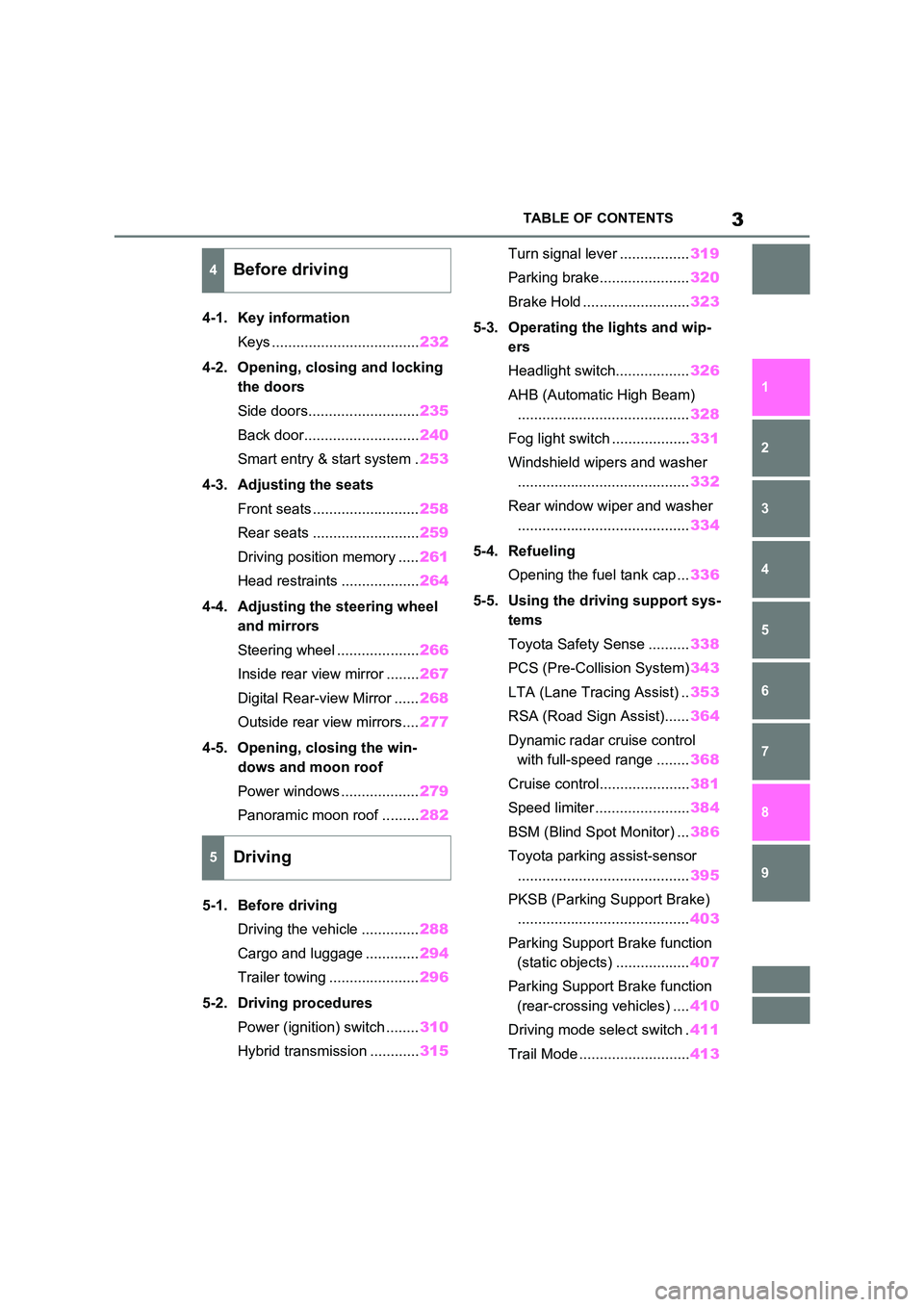
3TABLE OF CONTENTS
1
6
5
4
3
2
8
7
9
4-1. Key information
Keys .................................... 232
4-2. Opening, closing and locking
the doors
Side doors........................... 235
Back door............................ 240
Smart entry & start system . 253
4-3. Adjusting the seats
Front seats .......................... 258
Rear seats .......................... 259
Driving position memory ..... 261
Head restraints ................... 264
4-4. Adjusting the steering wheel
and mirrors
Steering wheel .................... 266
Inside rear view mirror ........ 267
Digital Rear-view Mirror ...... 268
Outside rear view mirrors.... 277
4-5. Opening, closing the win-
dows and moon roof
Power windows ................... 279
Panoramic moon roof ......... 282
5-1. Before driving
Driving the vehicle .............. 288
Cargo and luggage ............. 294
Trailer towing ...................... 296
5-2. Driving procedures
Power (ignition) switch ........ 310
Hybrid transmission ............ 315
Turn signal lever ................. 319
Parking brake...................... 320
Brake Hold .......................... 323
5-3. Operating the lights and wip-
ers
Headlight switch.................. 326
AHB (Automatic High Beam)
.......................................... 328
Fog light switch ................... 331
Windshield wipers and washer
.......................................... 332
Rear window wiper and washer
.......................................... 334
5-4. Refueling
Opening the fuel tank cap ... 336
5-5. Using the driving support sys-
tems
Toyota Safety Sense .......... 338
PCS (Pre-Collision System) 343
LTA (Lane Tracing Assist) .. 353
RSA (Road Sign Assist)...... 364
Dynamic radar cruise control
with full-speed range ........ 368
Cruise control...................... 381
Speed limiter ....................... 384
BSM (Blind Spot Monitor) ... 386
Toyota parking assist-sensor
.......................................... 395
PKSB (Parking Support Brake)
.......................................... 403
Parking Support Brake function
(static objects) .................. 407
Parking Support Brake function
(rear-crossing vehicles) .... 410
Driving mode select switch . 411
Trail Mode ........................... 413
4Before driving
5Driving
Page 23 of 718

21Pictorial index
■Ceiling (Left-hand drive vehicles)
“SOS” button*1................................................................................ P.66
Intrusion sensor and tilt sensor cancel switch*1......................... P.80
Panoramic moon roof switch*1.................................................... P.282
Electronic sunshade switch*1...................................................... P.282
Interior lights*2.............................................................................. P.444
Personal lights .............................................................................. P.444
Auxiliary box*1............................................................................... P.448
Vanity mirrors................................................................................ P.453
Sun visors*3................................................................................... P.453
Inside rear view mirror*1............................................................... P.267
Digital Rear-view Mirror*1............................................................. P.268
*1: If equipped
*2: The illustration shows the front, but they are also equipped in the rear.
*3: NEVER use a rearward facing child restraint on a seat protected by an ACTIVE
AIRBAG in front of it, DEATH or SERIOUS INJURY to the CHILD can occur.
( P.53)
A
B
C
D
E
F
G
H
I
Page 31 of 718
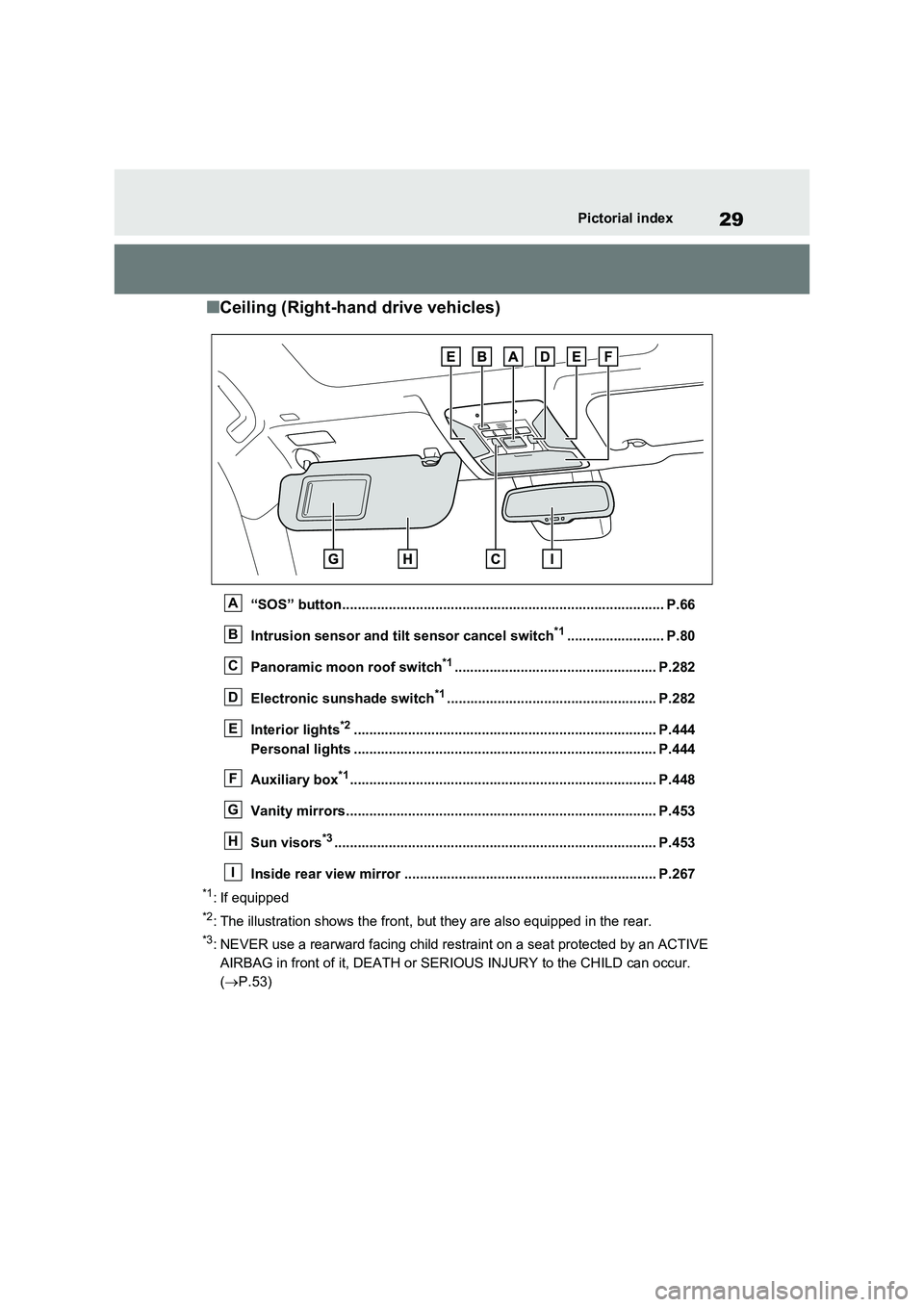
29Pictorial index
■Ceiling (Right-hand drive vehicles)
“SOS” button................................................................................... P.66
Intrusion sensor and tilt sensor cancel switch*1......................... P.80
Panoramic moon roof switch*1.................................................... P.282
Electronic sunshade switch*1...................................................... P.282
Interior lights*2.............................................................................. P.444
Personal lights .............................................................................. P.444
Auxiliary box*1............................................................................... P.448
Vanity mirrors................................................................................ P.453
Sun visors*3................................................................................... P.453
Inside rear view mirror ................................................................. P.267
*1: If equipped
*2: The illustration shows the front, but they are also equipped in the rear.
*3: NEVER use a rearward facing child restraint on a seat protected by an ACTIVE
AIRBAG in front of it, DEATH or SERIOUS INJURY to the CHILD can occur.
( P.53)
A
B
C
D
E
F
G
H
I
Page 42 of 718
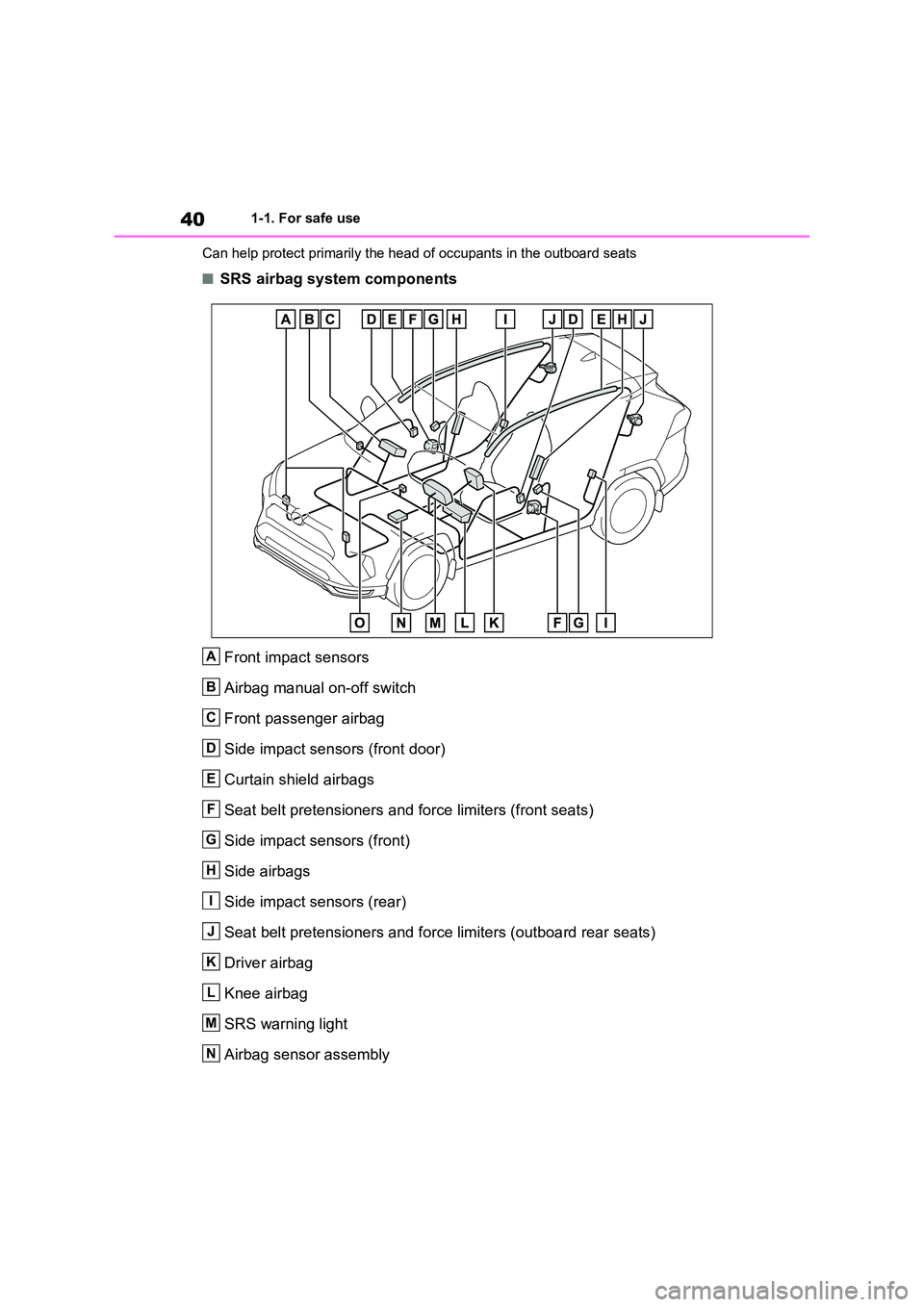
401-1. For safe use
Can help protect primarily the head of occupants in the outboard seats
■SRS airbag system components
Front impact sensors
Airbag manual on-off switch
Front passenger airbag
Side impact sensors (front door)
Curtain shield airbags
Seat belt pretensioners and force limiters (front seats)
Side impact sensors (front)
Side airbags
Side impact sensors (rear)
Seat belt pretensioners and force limiters (outboard rear seats)
Driver airbag
Knee airbag
SRS warning light
Airbag sensor assembly
A
B
C
D
E
F
G
H
I
J
K
L
M
N
Page 43 of 718
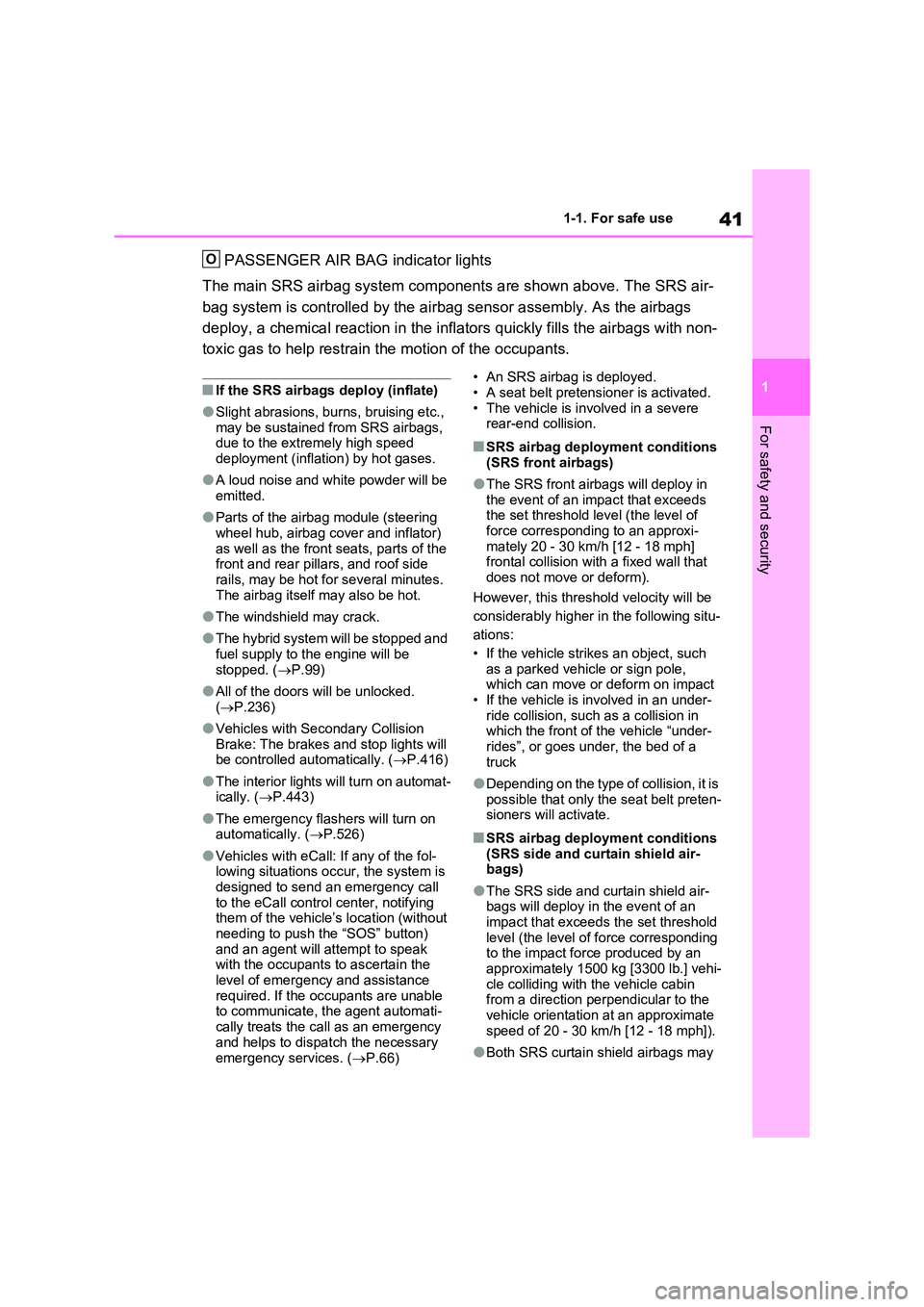
41
1
1-1. For safe use
For safety and security
PASSENGER AIR BAG indicator lights
The main SRS airbag system components are shown above. The SRS air-
bag system is controlled by the airbag sensor assembly. As the airbags
deploy, a chemical reaction in the inflators quickly fills the airbags with non-
toxic gas to help restrain the motion of the occupants.
■If the SRS airbags deploy (inflate)
●Slight abrasions, burns, bruising etc., may be sustained from SRS airbags, due to the extremely high speed
deployment (inflation) by hot gases.
●A loud noise and white powder will be
emitted.
●Parts of the airbag module (steering
wheel hub, airbag cover and inflator) as well as the front seats, parts of the front and rear pillars, and roof side
rails, may be hot for several minutes. The airbag itself may also be hot.
●The windshield may crack.
●The hybrid system will be stopped and
fuel supply to the engine will be stopped. ( P.99)
●All of the doors will be unlocked. ( P.236)
●Vehicles with Secondary Collision Brake: The brakes and stop lights will be controlled automatically. ( P.416)
●The interior lights will turn on automat- ically. ( P.443)
●The emergency flashers will turn on automatically. ( P.526)
●Vehicles with eCall: If any of the fol- lowing situations occur, the system is
designed to send an emergency call to the eCall control center, notifying them of the vehicle’s location (without
needing to push the “SOS” button) and an agent will attempt to speak with the occupants to ascertain the
level of emergency and assistance required. If the occupants are unable to communicate, the agent automati-
cally treats the call as an emergency and helps to dispatch the necessary
emergency services. ( P.66)
• An SRS airbag is deployed. • A seat belt pretensioner is activated.
• The vehicle is involved in a severe rear-end collision.
■SRS airbag deployment conditions
(SRS front airbags)
●The SRS front airbags will deploy in
the event of an impact that exceeds the set threshold level (the level of force corresponding to an approxi-
mately 20 - 30 km/h [12 - 18 mph] frontal collision with a fixed wall that does not move or deform).
However, this threshold velocity will be
considerably higher in the following situ-
ations:
• If the vehicle strikes an object, such as a parked vehicle or sign pole, which can move or deform on impact
• If the vehicle is involved in an under- ride collision, such as a collision in which the front of the vehicle “under-
rides”, or goes under, the bed of a truck
●Depending on the type of collision, it is possible that only the seat belt preten-sioners will activate.
■SRS airbag deployment conditions
(SRS side and curtain shield air- bags)
●The SRS side and curtain shield air-bags will deploy in the event of an impact that exceeds the set threshold
level (the level of force corresponding to the impact force produced by an approximately 1500 kg [3300 lb.] vehi-
cle colliding with the vehicle cabin from a direction perpendicular to the vehicle orientation at an approximate
speed of 20 - 30 km/h [12 - 18 mph]).
●Both SRS curtain shield airbags may
O
Page 73 of 718
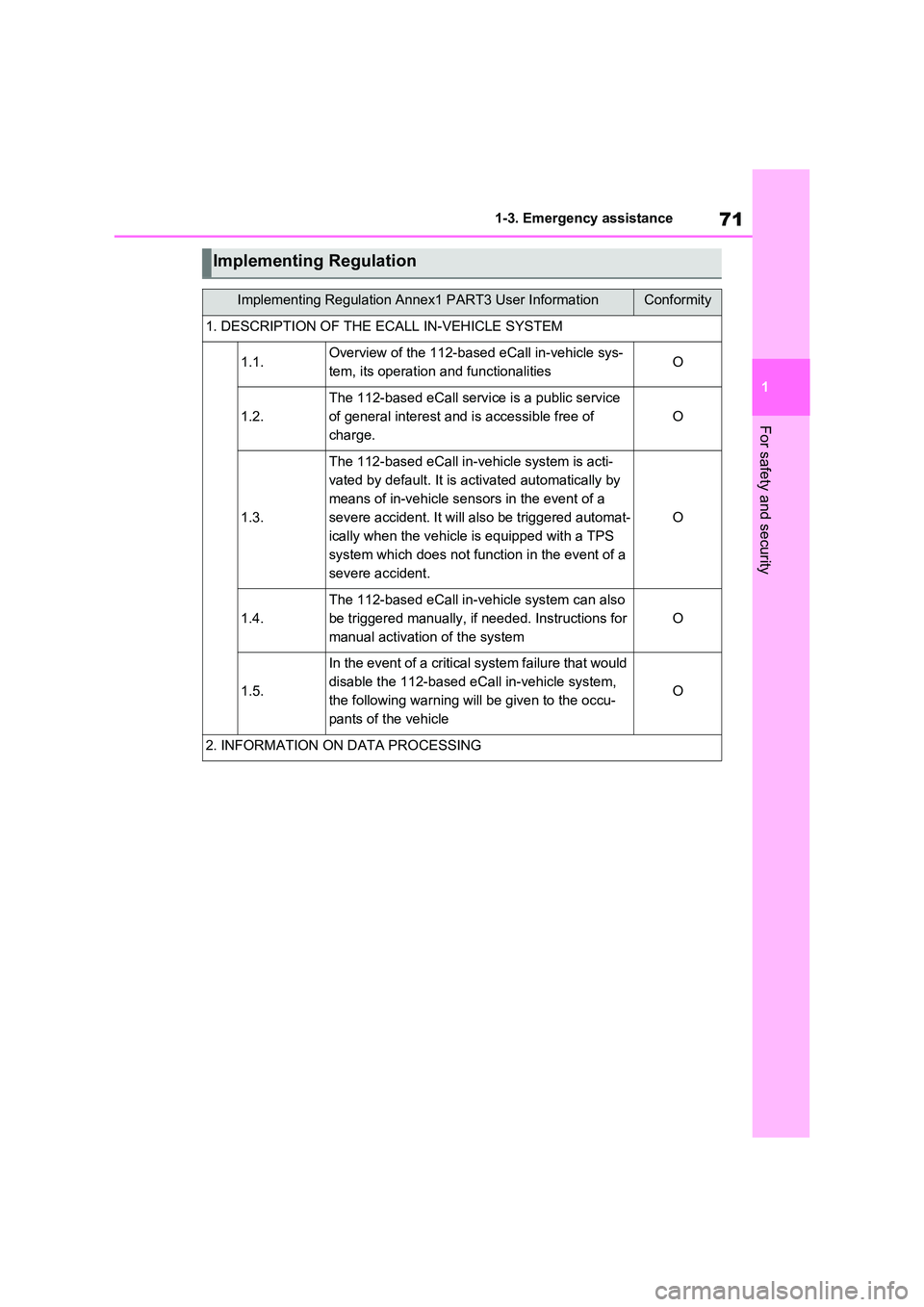
71
1
1-3. Emergency assistance
For safety and security
Implementing Regulation
Implementing Regulation Annex1 PART3 User InformationConformity
1. DESCRIPTION OF THE ECALL IN-VEHICLE SYSTEM
1.1.Overview of the 112-based eCall in-vehicle sys-
tem, its operation and functionalitiesO
1.2.
The 112-based eCall service is a public service
of general interest and is accessible free of
charge.
O
1.3.
The 112-based eCall in-vehicle system is acti-
vated by default. It is activated automatically by
means of in-vehicle sensors in the event of a
severe accident. It will also be triggered automat-
ically when the vehicle is equipped with a TPS
system which does not function in the event of a
severe accident.
O
1.4.
The 112-based eCall in-vehicle system can also
be triggered manually, if needed. Instructions for
manual activation of the system
O
1.5.
In the event of a critical system failure that would
disable the 112-based eCall in-vehicle system,
the following warning will be given to the occu-
pants of the vehicle
O
2. INFORMATION ON DATA PROCESSING
Page 80 of 718

781-4. Theft deterrent system
*: If equipped
■Setting
Turn the power switch to OFF, have
all the passengers exit the vehicle
and ensure that all the doors are
closed.
Using the entry function:
Touch the sensor area on the front
outside door handle twice within 5
seconds.
Using the wireless remote control:
Press twice within 5 sec-
onds.
■Canceling
Using the entry function:
Hold the front outside door handle.
Using the wireless remote control:
Press .
Double locking system*
Unauthorized access to the
vehicle is prevented by dis-
abling the door unlocking
function from both the interior
and exterior of the vehicle.
Vehicles employing this sys-
tem have labels on the front
side windows.
Setting/canceling the double
locking system
WARNING
■Double locking system precau- tion
Never activate the double locking sys-
tem when there are people in the vehicle because all the doors cannot be opened from inside the vehicle.
Page 81 of 718
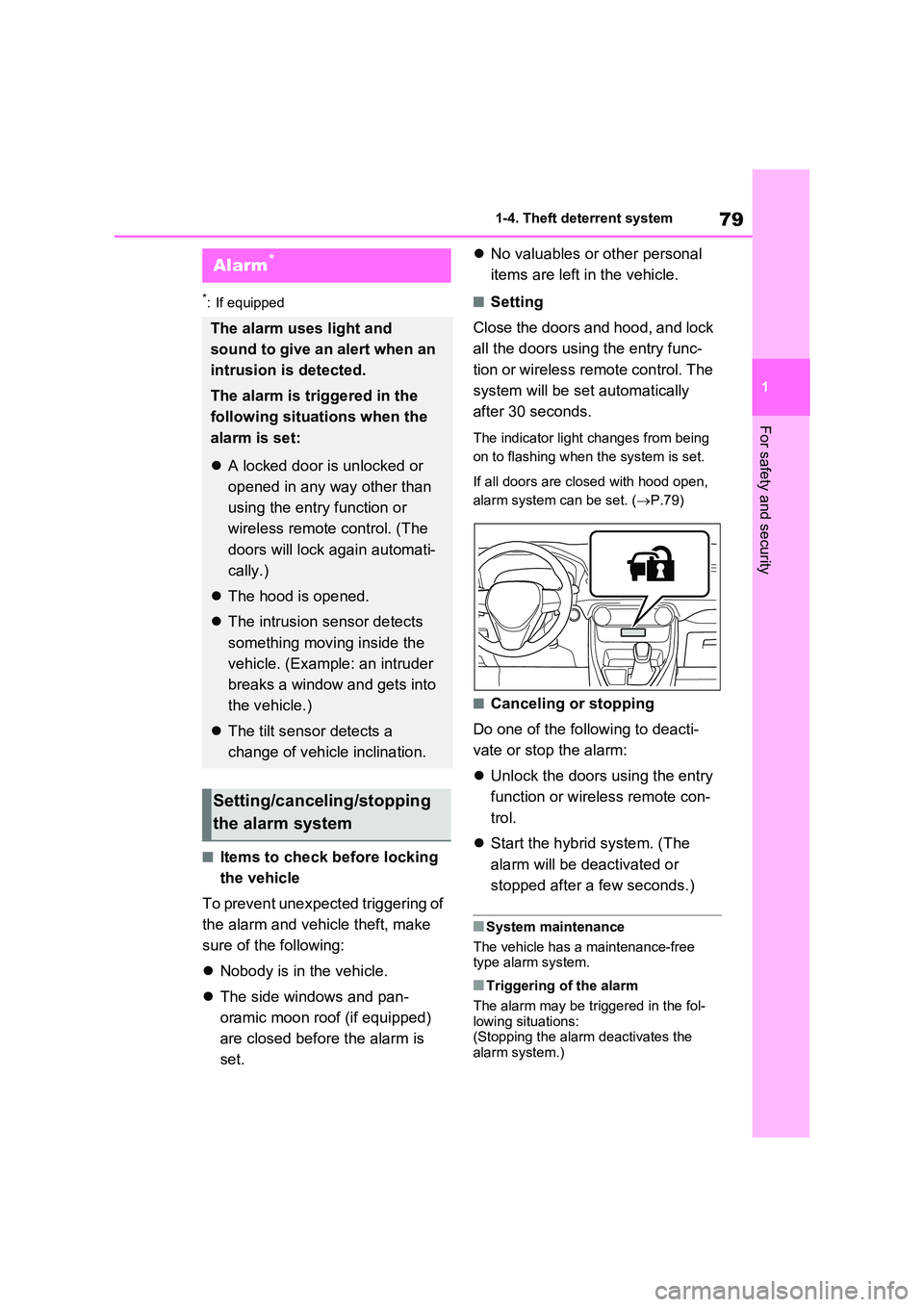
79
1
1-4. Theft deterrent system
For safety and security
*: If equipped
■Items to check before locking
the vehicle
To prevent unexpected triggering of
the alarm and vehicle theft, make
sure of the following:
Nobody is in the vehicle.
The side windows and pan-
oramic moon roof (if equipped)
are closed before the alarm is
set.
No valuables or other personal
items are left in the vehicle.
■Setting
Close the doors and hood, and lock
all the doors using the entry func-
tion or wireless remote control. The
system will be set automatically
after 30 seconds.
The indicator light changes from being
on to flashing when the system is set.
If all doors are closed with hood open,
alarm system can be set. ( P.79)
■Canceling or stopping
Do one of the following to deacti-
vate or stop the alarm:
Unlock the doors using the entry
function or wireless remote con-
trol.
Start the hybrid system. (The
alarm will be deactivated or
stopped after a few seconds.)
■System maintenance
The vehicle has a maintenance-free type alarm system.
■Triggering of the alarm
The alarm may be triggered in the fol- lowing situations:(Stopping the alarm deactivates the
alarm system.)
Alarm*
The alarm uses light and
sound to give an alert when an
intrusion is detected.
The alarm is triggered in the
following situations when the
alarm is set:
A locked door is unlocked or
opened in any way other than
using the entry function or
wireless remote control. (The
doors will lock again automati-
cally.)
The hood is opened.
The intrusion sensor detects
something moving inside the
vehicle. (Example: an intruder
breaks a window and gets into
the vehicle.)
The tilt sensor detects a
change of vehicle inclination.
Setting/canceling/stopping
the alarm system
Page 82 of 718

801-4. Theft deterrent system
●The doors are unlocked using the
mechanical key.
●A person inside the vehicle opens a
door or hood, or unlocks the vehicle using an inside lock button.
●The 12-volt battery is recharged or replaced when the vehicle is locked. ( P.573)
■Alarm-operated door lock
In the following cases, depending on the
situation, the door may automatically lock to prevent improper entry into the vehicle:
●When a person remaining in the vehi-cle unlocks the door and the alarm is
activated.
●While the alarm is activated, a person
remaining in the vehicle unlocks the door.
●When recharging or replacing the 12-volt battery.
■Customization (if equipped)
The alarm can be set to deactivate when the mechanical key is used to unlock.(Customizable features: P.596)
■The intrusion sensor and tilt
sensor detection
The intrusion sensor detects
intruders or movement in the
vehicle.
The tilt sensor detects changes
in vehicle inclination, such as
when the vehicle is towed away.
This system is designed to deter
and prevent vehicle theft but does
not guarantee absolute security
against all intrusions.
■Setting the intrusion sensor
and tilt sensor
The intrusion sensor and tilt sensor
will be set automatically when the
alarm is set. ( P.79)
■Canceling the intrusion sensor
and tilt sensor
If you are leaving pets or other
moving things inside the vehicle,
make sure to disable the intrusion
sensor and tilt sensor before setting
NOTICE
■To ensure the system operates correctly
Do not modify or remove the system.
If modified or removed, the proper operation of the system cannot be guaranteed.
Intrusion sensor and tilt
sensor
Page 83 of 718
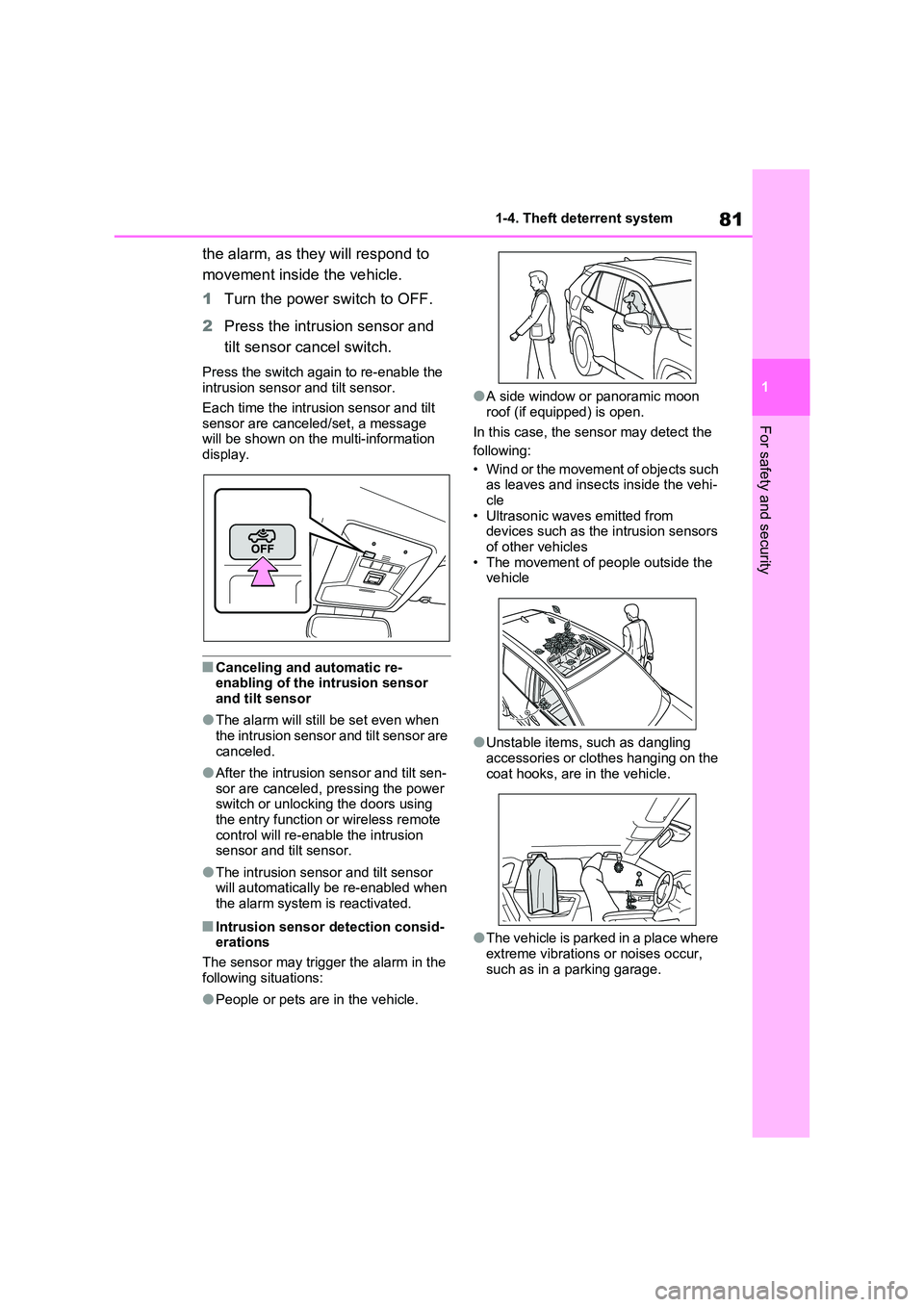
81
1
1-4. Theft deterrent system
For safety and security
the alarm, as they will respond to
movement inside the vehicle.
1 Turn the power switch to OFF.
2 Press the intrusion sensor and
tilt sensor cancel switch.
Press the switch again to re-enable the intrusion sensor and tilt sensor.
Each time the intrusion sensor and tilt
sensor are canceled/set, a message will be shown on the multi-information display.
■Canceling and automatic re-enabling of the intrusion sensor
and tilt sensor
●The alarm will still be set even when
the intrusion sensor and tilt sensor are canceled.
●After the intrusion sensor and tilt sen-sor are canceled, pressing the power switch or unlocking the doors using
the entry function or wireless remote control will re-enable the intrusion sensor and tilt sensor.
●The intrusion sensor and tilt sensor will automatically be re-enabled when
the alarm system is reactivated.
■Intrusion sensor detection consid- erations
The sensor may trigger the alarm in the
following situations:
●People or pets are in the vehicle.
●A side window or panoramic moon
roof (if equipped) is open.
In this case, the sensor may detect the
following:
• Wind or the movement of objects such as leaves and insects inside the vehi-
cle • Ultrasonic waves emitted from devices such as the intrusion sensors
of other vehicles • The movement of people outside the vehicle
●Unstable items, such as dangling accessories or clothes hanging on the
coat hooks, are in the vehicle.
●The vehicle is parked in a place where
extreme vibrations or noises occur, such as in a parking garage.